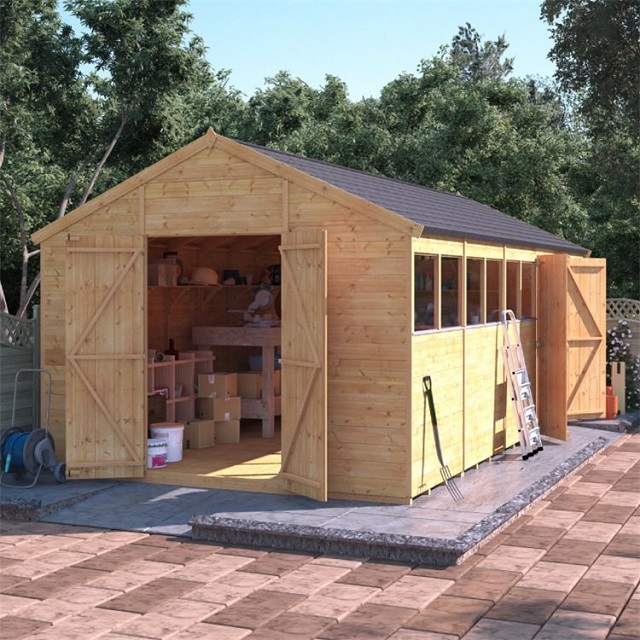Installing a shed in your backyard is a practical way to create an extra space where you can work, relax or simply store your tools and garden gadgets. This isn't a difficult work but it requires several things to consider such as materials, location, placement, size.
If you want a shed that is not too small, but not too big, such as a 4 metre shed, you should consider placing it in the right place where you can easily bring electricity but also keep the temperature pleasant.
Here are the things you need to consider before installing your shed.
What Shed is Best?
You might wonder if there is such a thing as the best shed, but the answer is yes. There are several things you should consider before buying and installing the shed. For instance, if you have a large yard, you could easily go with a larger option. The material is also important. Wood would be pricier than plastic, but then again, if you live in an area where it rains often, you'll have to do things to protect this material. Let's see some of the best shed materials.
Wood
Wood is a natural material that keeps consistent temperature even when the weather is hot. The downside is that it will shrink and expand when it rains, but with time the wood will return to its original state.
Metal
Source: gardenbuildingsdirect.co.ukPlastic
Sheds made of plastic are the easiest to install and will do their work perfectly. They won't rust, you won't have to care about corrosion, wood cracking or other maintenance problems. The only thing you need to do is to secure the base that will ensure the shed will stay in its place; it won't be funny to see the shed being blown away when the wind is blazing.
Where to Position My Shed?
If it's a storage for tools, garden stuff like a lawnmower and things like that, then be sure to install it in the shadow. This way the temperature will be more or less regulated, and you won't have to worry whether the sun and high temperatures would make damages to the things you keep inside.
If the shed is going to be used as a summer house, then make sure to install it with the windows and door facing south (so you can get enough sunlight and warmth).
Another thing to keep in mind when installing your shed is to make sure there's enough access to all sides.
Also, the location should have electrical supply or be close to the house so you can easily bring electricity (without digging the entire garden for the cables).
What Base to Use For the Shed?
It's crucial to provide a dry foundation and levelled surface. For larger sheds, such as 4 meter shed, it's best if you use a full concrete base. It's the ideal way to be sure that the base is solid and the surface is flat. Installing the shed directly over the grass (it's moist), can be risky for the wood.
However, if you decide to go build a concrete base, it's important that the surface is levelled and flat.
What Cladding to Use for My Shed
The three types of cladding you need to consider are overlap, tongue and groove and shiplap.
Overlap means boards overlapping into one another to turn rainwater; this is the most affordable roof option.
Tongue and groove are a bit pricier but it's also stronger and flexible. Shiplap is the priciest one but it also has the most benefits.
It's very similar to tongue and groove, but it contains a lop around the edge that stops rain from getting inside the shed. It will reduce the risk of warping, rotting and wood swelling.
Do I Need Permission to Build a Shed
New South Wales
In NSW your shed is the only detached structure in the backyard and isn't a shipping container. It shouldn't be larger than 20 square meters if you live in a residential area. For rural areas, the shed shouldn't be larger than 50 square meters.
It should be placed at least 900mm away from each boundary and should be raised off the ground (less than 3 meters). The shed shouldn't interfere with the fire safety of other buildings. The shed must be made of fire-prone materials (in case you live in a fire-prone area).
Queensland
The shed should be smaller than 10 square meters and shouldn't have any single wall longer than 5 meters. It shouldn't be taller than 2.4 meters and shouldn't have an average mean height of more than 2.1 meters.
South Australia
You won’t need to apply for council approval if your shed will be used as an extension to the house, rather than a separate home office or for other use. It should be smaller than 15 square meters and should have a width of fewer than 3 meters. The shed shouldn't be raised higher than 2.5 meters off the ground level and shouldn't be installed on a heritage land.
Tasmania
The shed should be installed in the backyard and should be less than 9 square meters, with no wall longer than 3 meters. It shouldn't be raised more than 2.4 off the ground. The shed's pitch roof should be less than 25 degrees.
Victoria
The shed shouldn't be larger than 10 square metres and shouldn't be higher than 3 meters. It shouldn't extend beyond the front wall of the main building and should be constructed of a material other than masonry.
Western Australia
Your shed shouldn't be taller than 2.4 meters and shouldn't be raised above 500mm from the ground. It shouldn't be within 900 mm of any other structure and should have a strong structure.





No comments:
Post a Comment